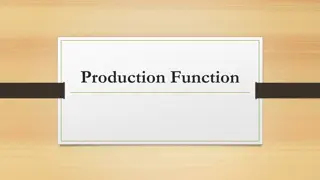The Homefront: U.S. War Production Efforts During World War II
During World War II, the United States mobilized its industries for total war production, converting peacetime factories into facilities for producing planes, tanks, rifles, and more. The U.S. became the Allies' biggest armaments supplier, producing millions of war supplies and significantly boosting the economy. The nation's industrial efforts led to impressive numbers of aircraft, tanks, and rifles being manufactured, contributing to the war effort and shaping post-war industrial landscapes.
Download Presentation

Please find below an Image/Link to download the presentation.
The content on the website is provided AS IS for your information and personal use only. It may not be sold, licensed, or shared on other websites without obtaining consent from the author.If you encounter any issues during the download, it is possible that the publisher has removed the file from their server.
You are allowed to download the files provided on this website for personal or commercial use, subject to the condition that they are used lawfully. All files are the property of their respective owners.
The content on the website is provided AS IS for your information and personal use only. It may not be sold, licensed, or shared on other websites without obtaining consent from the author.
E N D
Presentation Transcript
U.S. had the worlds 17thlargest military in 1939 Mobilized itself for total war production almost overnight once the nation entered the war Immediate conversion of peacetime industries into war production facilities Toy companies manufactured compasses Typewriter companies made rifles Piano factories made airplane motors Ford ceased producing cars & began turning out tanks and bombers
U.S. became Allies biggest armaments supplier 1940-1945: U.S. war plants produced millions of planes, tanks, jeeps, & guns Shipbuilders produced thousands of ships Jobless sank to fewer than 700,000 Earnings nearly doubled Typical factory worker $25 $47 Working overtime & brought home fat checks
From 1940 until Japanese surrender, U.S. produced: More than 300,000 aircraft 86,333 tanks 12.5 million rifles 107 aircraft carriers 352 destroyers By 1945, produced more than twice the war supplies of Germany, Italy, and Japan combined At war s end military orders totaled $330 billion National debt increased from $49 billion in 1941 to $259 billion in 1945
4 million people left their homes for other states with industry jobs Gulf & Pacific coasts (shipbuilding) Midwest & West (factories) Government spent billions of dollars to build factories & military bases Create industrial areas that will remain after WWII
Produced enough food to supply American people & Allies overseas
Office of War Mobilization Coordinated all government agencies involved in producing & distributing civilian goods War Production Board Directed conversions of existing factories to wartime production Supervised building of new plants Assigned raw materials Coordinated production & distribution of consumer goods
More than 6 million women, half of whom had never earned money before join workforce Government set up daycare centers for women whose husbands were serving in the war
Publicity campaign to encourage women to get jobs More than 5 million women joined the labor force during the war Showed that it was NOT unfeminine to work & would make an important contribution to war effort 1945 average woman s pay still less than 2/3 that of male Rosie the Riveter with flexed arm
1940 draft starts before attack on Pearl Harbor 1stpeacetime draft All men between the ages of 21-37 (extended to 18-37) 16 million men & women served during WWII 2/3 draftees 300,000 women 72,000 claimed conscientious objection
WAACS, WASPS, WAVES, SPARS, & Marines permit women to join Serve as nurses, office workers, drivers, and ferried planes Freed men from active duty ANC & NNC tended to wounded soldiers overseas
Government increased amount of money Americans had to pay in income taxes Included most middle- & lower- income groups for 1st time War Bonds Sold to control inflation
1941 = $49 billion; 1945 = $259 billion 2/5 was pay as we go; 3/5 borrowed New Deal + WWII = warfare welfare state
Controlled the flow of news at home Radio played wartime musical hits Bebop music becomes popular White Christmas Ban certain programs, sound effects, sirens, etc.
Government encouraged media to increase morale after unsuccessful start Movies Movie stars advertised war bonds Traveled overseas to entertain the troops War movies produced romanticized American & other Allied soldiers Stereotyped Japanese, Germans, and Italians
carclub Comic books with patriotic themes Slogans Kick Em in the Axis became popular http://maryvillepawprint.com/files/2011/07/Captain-America-The-First-Avenger-2011-Review.jpg
A long list of actors fought in the war Paul Newman Kirk Douglas Mel Brooks Ed McMahon Walter Matthau Pinup Girls Betty Grable Rita Hayworth
Bob Hope Assembled celebrities to entertain the American troops under the USO Glenn Miller joined Air Force and entertained the troops with orchestra Frank Capra Why We Fight Films hope2small
Dwight Eisenhower John Kennedy Lyndon Johnson Richard Nixon Gerald Ford Jimmy Carter Ronald Reagan George Bush Bob Dole
Plant victory gardens Buy war bonds Display window banners Recycle scrap metal, fabric, and old tires Cut back on travel Begin singing Star Spangled Banner at beginning of all ball games
Reduced demand by limiting what and how much people could buy Cut civilian purchases needed for war effort Gasoline, heating fuel, tires, coffee, sugar, meat, butter, canned goods Given ration coupon books distributed at schools
RED Points allowed 64 per month Meat, butter, fat, etc. Permitted people to buy about 2 lbs of meat per week BLUE Points allowed 48 per month Processed foods Tags with prices and point values found at the stores
72033sm 72038sm 72037sm 72036sm
Government imposed a national speed limit Average person entitled to 4 gallons per week People who needed cars for work were given more No limit placed on those who provided essential services, such as doctors Large black market grew with stolen and counterfeited ration cards, stamps & gas stickers World War II Poster Image
Behind each soldier are hundreds of civilian workers Depression was over Full employment was reality Confidence in victory was strong























